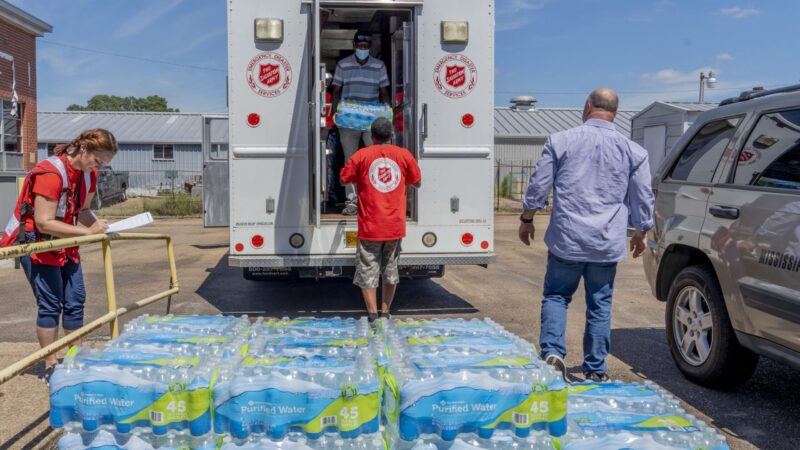Paying For Charter Schools In The South
Florida has about 650 charter schools. They are part of school districts but are privately managed and largely free of many of the rules governing traditional public schools. But as enrollment in charters has increased, so has the financial cost. WFSU’s Lynn Hatter reports for the Southern Education Desk that Tennessee and Georgia are also struggling to find ways to support their charter schools.
In Gadsden County, Florida, one of the lowest performing districts in the state, sits Crossroads Academy charter school. Crossroads most recently won national praise as a Blue Ribbon School of Excellence. But it didn’t start out that way. Principal Kevin Forehand says, it’s been an evolution.
“It actually evolved from an alternative program. When the charter school law started in 1996, we picked it up in 1997,” Forehand says. “I don’t want to say we had to shave the alternative image, but we had to become more than an alternative school.”
Yet for every three charter schools that succeeds, one fails. Florida has a 30-percent charter school failure rate. And a big reason for that is financial. Adam Miller, leader of Florida’s School Choice Office defends the number of closed schools and the method of counting them.
“It includes schools that merged, it includes that schools that never actually opened but got a number. ….there is some context that’s important. For example when you look at the state database, there’s also 1200 traditional public schools that show up as closed as well,” says Miller.
“I think we’re now at a point where we have to make a decision. Re-institute a moratorium on charters, or bleed them to death.”
Charter school lobbyist Jim Horne wants the state board of education to support more funding for charter schools. He’s a former Florida Education Commissioner. Charters have historically received less funding than their traditional school counterparts, that’s largely due to a disparity in school construction and maintenance dollars. During the past few years charters have gotten the bulk of the state-based funding for those projects. But Robert Weissert — Vice President of Research for the think tank Florida TaxWatch points out it’s not enough.
“As to how we fund it—whether its state money coming out or local money, it’s all taxpayer money funding public schools, and we need to find a distribution that’s fair for the students to make sure they’re going to school in a safe environment,” says Weissert.
The charter school lobby is once again eying local school district tax dollars to make up the difference. Some districts share that money with charters, others don’t. That’s created a system-within-a-system which both sides say is unfair. It’s a similar story in Tennessee, where less than 100 charter schools have managed to open and only a handful have closed.
Tennessee Charter School Center Policy Director Emily Lilley credits that slow and steady approach with Tennessee’s low-closure rate. But she notes that could soon start to change. Tennessee is also home to the Achievement School District, which oversees the conversion of low-performing traditional public schools into charters.
“We passed a piece of legislation last year that everyone colloquially referred to as the default closure act which says if a charter school appears on the state priority list—the bottom 5 percent eligible for ASC takeover — then that charter school would be automatically closed.”
That list comes out in 2017. Meanwhile Georgia, Florida’s Northern neighbor has 118 charters.
Louis Erste, Director of the Georgia Department of Education, says the state has been picky when it comes to who can operate a charter:
“We make it moderately harder to get a charter to make sure you can do a good job before we risk any education ill for any child who might attend your school,” says Erste.
In all three states charters get less dollars than their traditional public schools. Georgia has launched a commission on school funding to address the financial disparities. And Tennessee is also looking at ways to close the gap—doing like Florida and focusing in on those local school dollars for maintenance and construction.
This report is supported by a grant from the Corporation for Public Broadcasting. Tomorrow in the final segment the Southern Education Desk will look at the charter school movement in Mississippi and Alabama, the two most recent Southern states with charter school laws.
Q&A: A former New Orleans police chief says it’s time the U.S. changes its marijuana policy
Ronal Serpas is one of 32 law enforcement leaders who signed a letter sent to President Biden in support of moving marijuana to a Schedule III drug.
How food stamps could play a key role in fixing Jackson’s broken water system
JXN Water's affordability plan aims to raise much-needed revenue while offering discounts to customers in need, but it is currently tied up in court.
Alabama mine cited for federal safety violations since home explosion led to grandfather’s death, grandson’s injuries
Following a home explosion that killed one and critically injured another, residents want to know more about the mine under their community. So far, their questions have largely gone unanswered.
Crawfish prices are finally dropping, but farmers and fishers are still struggling
Last year’s devastating drought in Louisiana killed off large crops of crawfish, leading to a tough season for farmers, fishers and seafood lovers.
Lawmakers consider medical cannabis revamp
It’s been three years since Alabama lawmakers passed legislation establishing a system to govern medical cannabis in the state, yet not one prescription for the drug has been filled. The rollout has been delayed by lawsuits and conflict over the licensing process.
Man arrested in connection with device that exploded outside Alabama attorney general’s office
Kyle Benjamin Douglas Calvert, 26, of Irondale, Alabama, was arrested Wednesday on charges of malicious use of an explosive and possession of an unregistered destructive device, the U.S. attorney’s office said.







